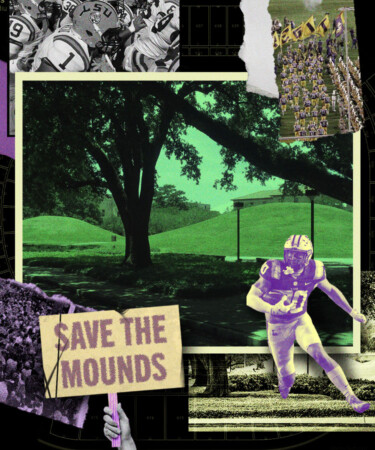When you hear the phrase “oldest man-made structure,” the first things that come to mind may be Stonehenge or the Great Pyramids of Giza. If you were to narrow it down to North America, you might think of Chichen Itza. However, a surprising June 2022 study published in the American Journal of Science reveals that two structures located just across the Gulf of Mexico predate the iconic Mayan ruin by nearly 3,000 years.
The LSU Campus Mounds — aptly named due to their location on the Louisiana State University campus and thankfully changed from their original name “Indian Mounds” — date back almost 11,000 years and were among a system of over 800 mounds constructed in the area by Native Americans that have since been destroyed. The southernmost mound, referred to as Mound B, was the first to be constructed, with sediment gathered from the same location where LSU’s Hill Memorial Library now stands.
Approximately 2,800 years following the construction of Mound B, the area was abandoned, likely due to a major climate event that caused the Louisiana landscape to become increasingly warmer and drier. When the population returned around 7,500 years ago, construction began on Mound A — the northernmost mound — with mud gathered from the area just in front of the entrance to where LSU’s Tiger Stadium resides today.
Both Mounds A and B were completed roughly 6,000 years ago, and samples gathered from layers of ash and charred microscopic bone fragments point to the idea that the mounds were once used for ceremonial purposes. Further solidifying that theory is the alignment of the mounds themselves. Eons ago, the crests of both mounds — aligned 8.5 degrees east of true north — would have aligned perfectly with the red giant Arcturus, one of the brightest visible stars from Earth.
Today, both mounds stand approximately 17 feet tall. When they were originally constructed, the two structures would have stood much taller, their shortened statures the result of years of erosion, much of which is the result of misuse by fans of LSU’s football team.
Despite the fact that the mounds have been around for thousands of years — not to mention that they are listed on the National Register of Historic Places — they have become a common place for fans to tailgate and party before heading into the nearby stadium. Not only does this present an issue for the longevity and preservation of the mounds, but it also poses a potential safety concern. Mound A was constructed with mud containing high levels of water, which, when agitated, liquefies. As LSU professor Brooks Ellwood told Baton Rouge news network WAFB9 in 2010, “the whole thing is collapsing,” and damage to the mounds is “especially amplified when it’s heavily loaded and when you get a lot of vibration. That’s on game day.”
Years of mistreatment have caused Mound A to slide and have visible deformations. In September 2010, LSU launched its “Save the Mounds” campaign to prevent people from walking, sitting, sliding, or biking on the mounds by surrounding the mounds with temporary fencing, signage forbidding access, and off-limits game-day rules.
Despite such preventive measures, protecting the mounds continues to be an issue for the university as students use the man-made hills to sled on when weather permits. In February 2021, student Sara Pellegrin told university news network Tiger TV that “no one has any business damaging these structures, and there should be consequences put in place to discourage and prevent further disregard and damage to them.” Eleven years earlier, Professor Ellwood shared a similar sentiment. “If it’s a Matisse hanging in a museum,” he said to WAFB9, “you don’t want people coming along and rubbing their hands on it.”
